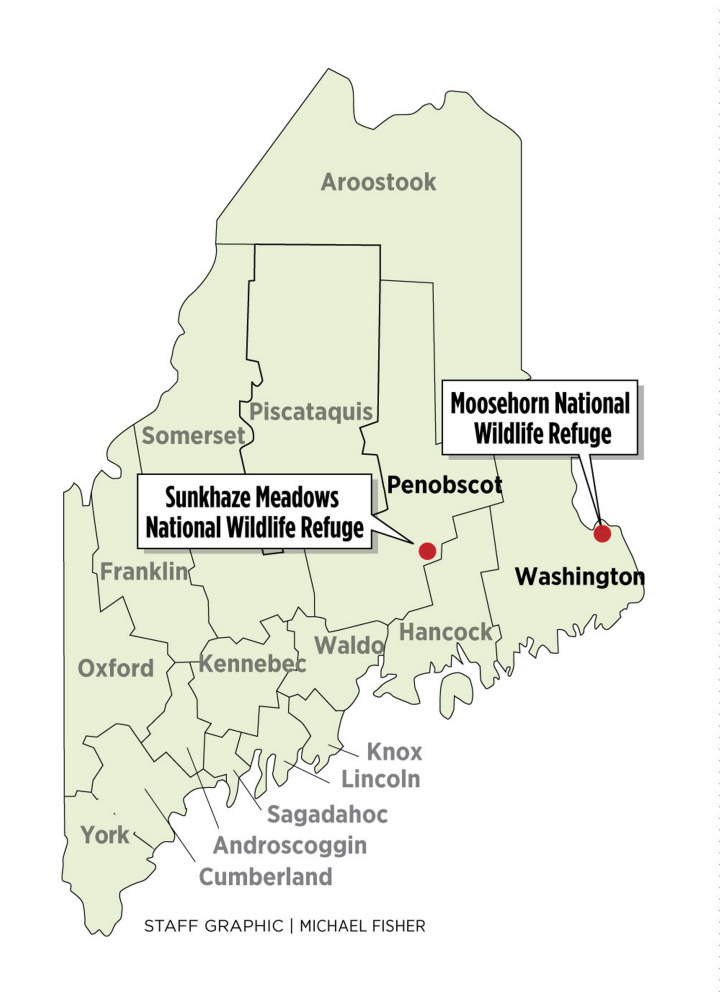A federal study is raising concerns about the impacts of hormone-disrupting chemicals on fish at national wildlife refuges across the Northeast, including two Maine refuges where nearly every smallmouth bass showed potential effects of chemical exposure.
Sunkhaze Meadows National Wildlife Refuge near Orono and Moosehorn National Wildlife Refuge outside of Calais were among five locations where biologists found enough evidence of physiological changes in bass for them to urge more study. Between 90 percent and 100 percent of the male smallmouth bass tested at both refuges had developed female characteristics in their reproductive systems, likely the result of endocrine-disrupting chemicals in the environment.
“We are talking about very subtle effects in their endocrine systems. We’re not talking about three eyes or additional fins,” said Andrew Major, an environmental toxicologist at the U.S. Fish and Wildlife Service in Concord, New Hampshire. “But this is an indicator of the health of the watershed. Now that we found this, we have to go back and say what does this mean?”
Scientists have long known that humans’ increasing use of “endocrine-disrupting chemicals” – whether in birth control pills, agricultural pesticides and herbicides, or other industrial compounds – is having an impact on people and wildlife. Such chemicals often mimic naturally occurring hormones such as estrogen in women and androgen in men.
The concern is whether exposure to the chemicals could interfere with human fertility and increase the risk of certain diseases, particularly endometriosis and some forms of cancer. Studies suggest that the risks may be greatest for pregnant women, fetuses or young infants whose organ and neural systems are still developing.
The study does not recommend that humans avoid eating the fish. However, the Maine Center for Disease Control & Prevention already advises that pregnant women or those who may become pregnant, nursing mothers and young children avoid freshwater fish consumption – except for brook trout and landlocked salmon – because the fish contain mercury.
Major was part of a team of researchers from the U.S. Fish and Wildlife Service and the U.S. Geological Survey who collected smallmouth and largemouth bass from waters in or near 19 national wildlife refuges in 11 northeastern states over the course of two years. The biologists expected to find the some signs of hormone-disrupting chemicals, such as male fish developing immature ovaries as well as the presence of a protein not normally present in males unless they have been exposed to estrogen.
But the extent of the evidence surprised them.
Roughly 85 percent of the smallmouth bass that were tested, and 27 percent of the largemouth bass, were “intersex,” meaning they had developed immature eggs in their testes, according to a study the team published in the latest edition of the scientific journal Ecotoxicology and Environmental Safety.
“We expected to see some refuges with high smallmouth bass (intersex) prevalence, but we didn’t expect to see everyone at between 60 and 100 percent,” said Fred Pinkney, senior biologist with the U.S. Fish and Wildlife Service’s environmental contaminants program, based in Maryland.
The team deliberately chose refuges where they suspected the watershed might be affected by endocrine-disrupting chemicals from such sources as municipal wastewater treatment plants, farms or manufacturing facilities. Sunkhaze and Moosehorn were chosen because their watersheds are located downriver from pulp and paper mills that discharge treated wastewater, although Major said it was too early to say whether discharges from the mills were linked to what they found.
The team chose to collect bass because they are a widespread, hardy species that has been studied before for the impacts of endocrine-disrupting chemicals. But Major said bass could be the proverbial “canary in the coal mine.”
“They are not all that sensitive, but other species could be very sensitive,” Major said.
Endocrine-disrupting chemicals are found in a vast array of products, from detergents and food packaging to flame retardants and pharmaceuticals. The effects of the chemicals are a growing field of scientific study, and some states – including Maine – have started restricting the use of some chemicals, such as bisphenol A, or BPA. The National Institute of Environmental Health Sciences, a division of the National Institutes of Health, says endocrine disruptors may be most problematic in the young.
The institute supports studies to determine whether exposure to endocrine disruptors may result in human health effects.
Members of the federal research team said it is too early to draw any conclusions about the bass study but wrote in their published paper that further investigations “should better inform management decisions on lands on or near National Wildlife Refuges.”
“I think we just need to take a closer look,” Pinkney said.
Send questions/comments to the editors.




Success. Please wait for the page to reload. If the page does not reload within 5 seconds, please refresh the page.
Enter your email and password to access comments.
Hi, to comment on stories you must . This profile is in addition to your subscription and website login.
Already have a commenting profile? .
Invalid username/password.
Please check your email to confirm and complete your registration.
Only subscribers are eligible to post comments. Please subscribe or login first for digital access. Here’s why.
Use the form below to reset your password. When you've submitted your account email, we will send an email with a reset code.